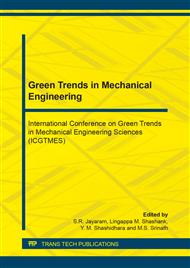[1]
ASM Hand book, Materials Park, Ohio, USA, ASM International, Volume 18(1992).
Google Scholar
[2]
W. Giwdon, Stachowiak Andrew, W. Batchelor, Engineering Tribology, third ed., Elsevier, 676 (2005).
Google Scholar
[3]
C. Santulli, M. Janssen, G. Jeronimidis, Partial replacement of E-glass fibres with flax fibres in composites and effect on falling weight impact performance, J. Mater. Sci. 40 (2005) 3581-3585.
DOI: 10.1007/s10853-005-2882-y
Google Scholar
[4]
M.T. Dehkordi, H. Nosraty, M.M. Shokrieh, G. Minak, D. Ghelli. Low velocity impact properties of intraply hybrid composites based on basalt and nylon, woven fabrics. J. Mater. Des. 31 (2010) 3835–3844.
DOI: 10.1016/j.matdes.2010.03.033
Google Scholar
[5]
M.T. Dehkordi, H. Nosraty, M.M. Shokrieh, G. Minak, D. Ghelli. The influence of hybridization on impact damage behavior and residual compression strength of intraply basalt/nylon hybrid composites. J. Mater. Des. 43 (2013) 283–290.
DOI: 10.1016/j.matdes.2012.07.005
Google Scholar
[6]
T. Deak, T. Czigány. Chemical composition and mechanical properties of basalt and glass fibers: a comparison. J. Text. Res. 79 (2009) 645–51.
Google Scholar
[7]
T. Czigány, J. Vad, K. Pölöskei. Basalt fiber as reinforcement of polymer composites. J. Period Polytech. Mech. Eng. 49 (2005) 3–14.
Google Scholar
[8]
N. Hameed, P. A. Sreekumar, B. Francis, W. Yang and S. Thomas. Morphology, Dynamic Mechanical and Thermal Studies on Poly(styrene-co-acrylonitrile) Modified Epoxy Resin/Glass Fibre Composites. J. Composites Part A, 38 (2007) 2422-2432.
DOI: 10.1016/j.compositesa.2007.08.009
Google Scholar
[9]
S. Öztürk. The effect of fibre content on the mechanical properties of hemp and basalt fibre reinforced phenol formaldehyde composites. J. Mater. Sci. 40 (2005) 4585–92.
DOI: 10.1007/s10853-005-1103-z
Google Scholar
[10]
T. Czigány, K. Pölöskei, J. Karger-Kocsis. Fracture and failure behavior of basalt fiber mat reinforced vinylester/epoxy hybrid resins as a function of resin composition and fiber surface treatment. J Mater. Sci. 40 (2005) 5609–18.
DOI: 10.1007/s10853-005-1273-8
Google Scholar
[11]
W. Mingchao, Z. Zuoguang, L. Yubin, L. Min, S. Zhijie. Chemical durability and mechanical properties of alkali-proof basalt fiber and its reinforced epoxy composites. J. Reinf. Plast. Comp. 27 (2008) 393–407.
DOI: 10.1177/0731684407084119
Google Scholar
[12]
V. Fiore, G. Di Bella, A. Valenza. Glass-basalt/epoxy hybrid composites for marine applications. J. Mat. Des. 32 (2011) 2091-99.
DOI: 10.1016/j.matdes.2010.11.043
Google Scholar
[13]
S.W. Koh, J.K. Kim, Y.W Mai. Fracture toughness and failure mechanisms in silica filled epoxy resin composites: effects of temperature and loading rate. J. Polymer 34 (1993) 3446–3455.
DOI: 10.1016/0032-3861(93)90474-o
Google Scholar
[14]
B.R. Raju, B. Suresha, R.P. Swamy. Investigations on mechanical and tribological behaviour of particulate filled glass fabric epoxy composites. J. Minerals and Materials Charct. and Engg. 01 (2013) 160–167.
DOI: 10.4236/jmmce.2013.14027
Google Scholar
[15]
B. Suresha, G. Chandramohan, Siddaramaiah, P. Samapthkumaran, S. Seetharamu. Three-body abrasive wear behaviour of carbon and glass fiber reinforced epoxy composites, J. Mat. Sci. and Eng. A 443 (2007) 285–291.
DOI: 10.1016/j.msea.2006.09.016
Google Scholar
[16]
Li Chang. Tribological properties of high temperature resistant polymer composites with fine particles. J. Tribol. 40 (2007) 1170–8.
Google Scholar


